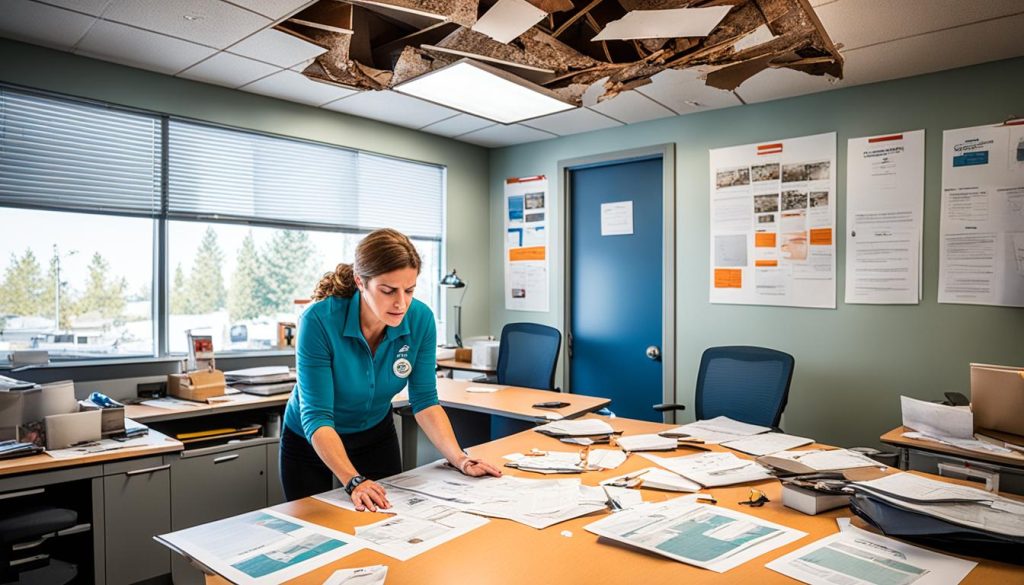Did you know that there are over 500,000 earthquakes each year worldwide? While many of these may be too small to be felt, the threat of a devastating earthquake is a reality that should not be ignored. Understanding the importance of earthquake preparedness can make all the difference when it comes to staying safe and protecting your loved ones.
Key Takeaways:
- Earthquakes can happen anywhere, so it’s important to assess your personal earthquake risk.
- Practice the “Drop, Cover, and Hold On” technique with your family and coworkers to stay safe during an earthquake.
- Create an emergency plan that includes communication and meeting points.
- Build an emergency supply kit with essential items like food, water, flashlight, and a fire extinguisher.
- Secure heavy items in your home and consider obtaining earthquake insurance for added protection.
Prepare Before an Earthquake
It’s crucial to take proactive steps to prepare for an earthquake. By following these preparedness measures, you can enhance your safety and minimize potential risks when an earthquake strikes.
- Practice the “Drop, Cover, and Hold On” technique: Familiarize yourself with this recommended safety practice. Regularly practice it with your family and coworkers to ensure everyone knows what to do in an earthquake. This technique involves dropping to the ground, taking cover under a sturdy piece of furniture, and holding on until the shaking stops.
- Create an emergency plan: Develop a comprehensive disaster response plan that includes an out-of-state contact person and a designated meeting point. This will help you stay connected with your loved ones and facilitate a coordinated response.
- Build an emergency earthquake kit: Assemble an emergency kit containing essential items like non-perishable food, water, a flashlight, a fire extinguisher, and a whistle. These supplies should be sufficient to sustain you and your family for several days in the event of a disruption to basic services.
- Secure heavy items: Secure heavy furniture, appliances, and objects in your home to prevent them from toppling over during an earthquake. This can be achieved by using wall straps, brackets, or other suitable anchors.
- Consider structural improvements: Assess your home for structural vulnerabilities that could pose risks during an earthquake. Consult with a professional to identify any necessary repairs or reinforcements to ensure your building can withstand seismic activity.
- Obtain earthquake insurance: Standard homeowner’s insurance policies generally do not cover earthquake damage. Therefore, it is advisable to obtain earthquake insurance to protect your property and possessions in the event of seismic activity.
By preparing before an earthquake, you are taking important steps to safeguard yourself, your loved ones, and your property. Remember, preparedness is key to effectively responding to an earthquake and minimizing its impact on your life.
Stay Safe During an Earthquake
During an earthquake, it is crucial to prioritize your safety and take necessary precautions to protect yourself. Here are some earthquake safety tips to keep in mind:
- If you are in a car when an earthquake strikes, pull over to a safe location and stop. Remember to set your parking brake and avoid stopping under bridges, overpasses, or near buildings.
- If you are in bed, turn face down and cover your head and neck with a pillow to shield yourself from potential debris.
- When outdoors, stay away from buildings, trees, streetlights, and utility wires. Move to an open area, if possible, to reduce the risk of falling objects.
- If you are indoors, stay inside and avoid doorways, as they do not provide adequate protection. Instead, seek shelter under a sturdy piece of furniture, such as a table or desk. Drop to your hands and knees, cover your head and neck with your arms, and hold on tightly to the furniture.
- If you are unable to drop to the floor due to mobility issues, bend forward and protect your head with your arms. Hold on to your neck with both hands for added safety.
Remember to stay calm during an earthquake and follow these safety precautions. By doing so, you can minimize the risk of injury and increase your chances of staying safe.
Be Prepared and Stay Safe
Adhering to earthquake safety tips and maintaining a disaster response plan are crucial steps in ensuring your safety during seismic events. If you experience an earthquake, remain vigilant and avoid panicking. Following these safety guidelines can help mitigate the potential risks and enhance your preparedness. Remember, your safety comes first.
Stay Safe After an Earthquake
Following an earthquake, it is crucial to be aware of the potential hazards that can arise. These hazards may include damaged buildings, leaking gas and water lines, and downed power lines. To ensure your safety and the safety of those around you, it is essential to take the appropriate actions. Here are some guidelines to follow:
- If you feel any aftershocks, be prepared to “Drop, Cover, and Hold On” as these are common following the main shock of an earthquake.
- If you find yourself in a damaged building, immediately evacuate and move away from the structure. It is crucial not to enter damaged buildings, as they pose a significant risk of collapsing.
- If you become trapped in debris, use your mobile phone to send a text message, or bang on a pipe or wall to alert rescuers of your location.
- For added protection, cover your mouth with your shirt to avoid inhaling dust and debris. Instead of shouting, use a whistle or other signaling device to avoid exhaust yourself.
- If you are in an area that is at risk of tsunamis, promptly move inland or to higher ground after the shaking stops.
- After ensuring your safety, check yourself and others for any injuries. Provide assistance to those in need if you have received proper training.
- Stay updated with local news reports for emergency information and guidance.
- Register on the American Red Cross “Safe and Well” website to inform others that you are safe and well.
Remember, the immediate aftermath of an earthquake can be a critical time for your safety. By following these guidelines, you can minimize further risks and ensure your well-being and that of your loved ones.
| Common Hazards After an Earthquake | Protective Measures |
|---|---|
| 1. Damaged buildings | – Evacuate immediately and move away from the structure. – Do not enter damaged buildings. |
| 2. Leaking gas and water lines | – Turn off utilities if safe to do so. – Report gas leaks to authorities. – Avoid using open flames or electrical appliances. |
| 3. Downed power lines | – Stay away from downed power lines. – Contact the local utility company to report the issue. |
Additional Resources for Earthquake Preparedness
When it comes to earthquake preparedness, knowledge is key. Fortunately, there are numerous resources available to help you understand the risks and take proactive measures to stay safe. By utilizing these resources, you can enhance your earthquake preparedness and have a better understanding of what to do in the event of a seismic event.
One valuable resource is Ready.gov, a website provided by the United States government. Ready.gov offers a comprehensive guide to earthquake preparedness, including information on how to create an emergency earthquake kit and develop a disaster response plan. The website provides practical tips and guidelines for individuals, families, and communities.
Another trusted source of information is the Federal Emergency Management Agency (FEMA). FEMA.gov provides up-to-date information on current disaster declarations and offers valuable resources to help you prepare for earthquakes. Additionally, FEMA has a mobile app that can assist you with disaster applications and provide guidance during emergencies.
“Being prepared can make a significant difference in your ability to respond effectively and stay safe during an earthquake.”
The American Red Cross is also a reliable resource for earthquake preparedness. Their website offers a wide range of materials, including earthquake safety videos, tip sheets, and detailed information on how to create an effective emergency earthquake kit. The Red Cross is dedicated to helping individuals and communities be prepared for disasters of all kinds.
The U.S. Geological Survey (USGS) Earthquake Hazards Program is another valuable resource. The USGS provides scientific information on earthquake risks, monitors seismic activity, and offers educational materials to increase public awareness. Their website offers comprehensive information and resources for understanding earthquakes and their potential impact.
The Earthquake Country Alliance is a nonprofit organization that focuses on earthquake education and preparedness. Their website provides valuable resources, including safety tips, earthquake preparedness guides, and information on how to develop a disaster response plan.
Remember, earthquake preparedness is a crucial step in ensuring the safety and well-being of yourself and your loved ones. By utilizing these additional resources, you can enhance your knowledge and be better prepared to face any seismic event that may occur.
Conclusion
Earthquake preparedness is essential for safeguarding yourself and your community during seismic events. By implementing the “Drop, Cover, and Hold On” technique, creating a comprehensive emergency plan, and assembling a well-stocked supply kit, you can significantly enhance your readiness to respond to an earthquake.
During an earthquake, remember to follow safety precautions to minimize risks and protect yourself from potential hazards. After the shaking stops, be cautious of damaged buildings, gas leaks, and downed power lines. Expect aftershocks and be prepared to take immediate action. Stay informed by monitoring local news updates and consider registering on the American Red Cross “Safe and Well” website to let others know you are safe.
Maximize your earthquake preparedness by exploring the additional resources available. FEMA.gov provides up-to-date information on disaster declarations, while the FEMA mobile app can assist with disaster applications. The American Red Cross offers valuable earthquake safety videos and tip sheets on their website. The U.S. Geological Survey Earthquake Hazards Program and the Earthquake Country Alliance also provide invaluable resources for understanding earthquake risks.
By prioritizing earthquake preparedness and taking proactive steps, you can greatly enhance your ability to respond effectively and stay safe during an earthquake. Remember that being prepared can make a significant difference in minimizing the impact of earthquakes on you and your loved ones. Stay informed, stay prepared, and stay safe.



